Mar 04, 2013
Wrong Prediction, Wrong Science; Unless It’s Government Climate Science.
By Dr. Tim Ball
In a comment on the WUWT article about the abject failure of the United Kingdom Weather Office (UKMO) weather forecasts, Doug Huffman wrote,
“Each forecast must be accompanied by the appropriate retro-cast record of previous casts”
I pointed out years ago that Environment Canada (EC) publishes such information. In doing so they expose a similar horrendous story of absolute failure. This likely indicates why it is not done by others, but provides adequate justification for significantly reducing the role of the agency.
Both EC and UKMO predictions fail. The failure parallels Richard Feynman’s comment.
“It doesn’t matter how beautiful your theory is, it doesn’t matter how smart you are. If it doesn’t agree with experiment, it’s wrong.”
If your prediction (forecast) is wrong; your science is wrong. Unlike the IPCC, they cannot avoid the problem by calling them projections, not predictions. They can and do avoid accountability.
We recently learned that the UKMO have revised their forecast for the period 2013 to 2017. In a press release they,
“confirmed that over the next five years temperatures will be 0.43 degrees above the 1971-2000 average, instead of the previously forecast 0.54 degrees, a 20 per cent reduction.”
That amount of change means the science is wrong, which they won’t admit. Instead, they claim the effects of CO2 are being surprised by “natural cycles.” What nonsense! They are saying when temperatures are flat or even cooling it is because of natural cycles. If temperatures increase it is because of CO2. These are statements would fail a first year university climate paper. The error indicated by the amount of reduction is sufficient to close the department.
Initially I thought EC was admirable for publishing results of how wrong they were. Now I realize it only shows arrogance and sense of unaccountability: we fail, but you must listen, act, and keep paying. It underscores the hypocrisy of what they do. More important, it shows why they and all national weather agencies must be proscribed. It is time to reduce all national weather offices to data collection agencies. When bureaucrats do research it is political by default. The objective rapidly becomes job preservation; perpetuate and expand rather than solve the problem.
EC is a prime example of why Maurice Strong set up the IPCC through the World Meteorological Organization (WMO) and member national weather agencies. EC participated and actively promoted the failed work of the Intergovernmental Panel on Climate Change (IPCC) from the start. An Assistant Deputy Minister (ADM) of EC chaired the founding meeting of the IPCC in Villach Austria in 1985. It continues, as they sent a large delegation to the recent Doha conference on climate change. Their web site promotes IPCC work as the basis for all policy on energy and environment. They brag about their role as a world class regulator. All this despite the fact their own evidence shows the complete inadequacy of their work.
See the post here for the forecasts and verifications.
Everyone knows that regional weather forecasts are notoriously unreliable, especially beyond 48 hours. This fact weakened the credibility of the IPCC predictions with the public from the start. Some supporters of the IPCC position tried to counteract the problem by saying that climate forecasts were different from weather forecasts. It is a false arguement. Climate is the average of the weather, so if the weather science is wrong the climate science is wrong.
Some experts acknowledge that regional climate forecasts are no better than short term weather forecasts. New Scientist reports that Tim Palmer, a leading climate modeler at the European Centre for Medium – Range Weather Forecasts in Reading England saying,
“I don’t want to undermine the IPCC, but the forecasts, especially for regional climate change, are immensely uncertain.”
In an attempt to claim some benefit, we’re told,
“...he does not doubt that the Intergovernmental Panel on Climate Change (IPCC) has done a good job alerting the world to the problem of global climate change. But he and his fellow climate scientists are acutely aware that the IPCC’s predictions of how the global change will affect local climates are little more than guesswork.”
The IPCC have deliberately misled the world about the nature, cause and threat of climate change and deceived about the accuracy of their predictions (projections), for a political agenda.
Some claim the failures are due to limited computer capacity. It makes no difference. The real problems are inadequate data, lack of understanding of most major mechanisms, incorrect assumptions, and a determination to prove instead of falsify the AGW hypothesis.
Einstein’s definition,
“Insanity: doing the same thing over and over again and expecting different results”
applies. However, EC do the same thing over and over with results that indicate failure yet fail to make adjustments as the scientific method requires. What is more amazing and unacceptable is they use public money, are essentially unaccountable yet demand the public and politicians change their energy and economic policies. On their web site, they state;
“The Government of Canada supports an aggressive approach to climate change that achieves real environmental and economic benefits for all Canadians.”
They could begin by reducing EC to data collection. Their failures are more than enough to justify termination in any other endeavour. Another is their involvment and political promotion of well documented IPCC corruption.
----------
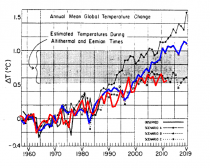
Enlarged
See Steve McIntyre’s post where a deceptive cherry picking by Michael Mann who claims Hensen’s forecast has been accurate (accomplished by using only land temperatures and stopping in 2005). and the devious and dangerous and totally delusional Naomi Oreskes (my dog knows more about climate than this phoney) who claims of all things they are too conservative! I hear from attendees that this duo did a marvelous imitation of dumb and dumber at this year’s AGU, which is racing with the AMS to see which society can go downhill faster.
Oreskes’ starting point was that models had supposedly under-estimated relative to observations - a starting-point that seems oddly disconnected to the IPCC graphic shown above but, hey, Oreskes is an expert in manufactured disinformation. If Oreskes was not in fact wrongfooted by Mann, then one would like to know the provenance of her assertion that models were “underestimating” observed temperature increases.
Oreskes then purported to ponder on the institutional factors that supposedly caused such under-estimates by climate scientists. Oreskes had no doubt as to where the “blame” lay. Not with the scientists themselves. of course not. Oreskes placed the blame squarely on climate skeptics. According to Oreskes, their intimidation had led climate scientists to pull their punches and make forecasts that were too conservative.
See this great response to Mann’s response to McIntyre’s recounting of the attempt by two of the worst offenders to try and save a failing science.
Feb 27, 2013
Using Energy and Happy about It
By Steve Goreham
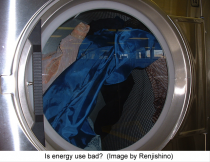
Last week I received a “Home Energy Report” flyer from Commonwealth Edison, my electricity provider in northern Illinois. The leaflet compared my energy usage to neighbors over the last two months and declared, “You used 41% MORE electricity than your efficient neighbors.” Should I be concerned about this?
My wife and I use energy, but don’t waste it. For years I’ve driven my family batty, turning off lights in vacated rooms. During the summer, my wife dries laundry in the sunshine, rather than in the dryer. We also have many of the compact fluorescent bulbs. We take these measures to lower our energy bills, not for other motives.
Isn’t it odd that ComEd, a company in the energy business, is encouraging their customers not to use it? Imagine a mailer from Coca-Cola pointing out that you drank 41% MORE soft drinks than your neighbor. Or a letter sent from Apple telling you that you needed to reduce your iPhone
and iPad purchases.
A visit to the ComEd website provides some answers. First, the company is required to use part of customer payments to urge Illinois customers to reduce electricity consumption by the Illinois Public Act 95-0481. But second, the website is filled with ideological nonsense. In the Saving Energy section of the website, we find a yellow “Power Bandit” and the statement, “Saving Energy was never so much fun! Beat the Power Bandit and learn lots of ways to save energy, save money and help save the planet!” Does ComEd really believe that we can save the planet by changing light bulbs?
For decades, environmental groups have waged war on energy. They warn that increased energy usage will pollute the Earth, destroy the climate, and rapidly exhaust natural resources. They demand substitution of dilute, intermittent, and expensive wind, solar, and biofuel energy for traditional hydrocarbon or nuclear power, which is an excellent way to reduce energy usage. They tell us that nations which use the most energy do the most environmental damage.
National and state governments have swallowed the “energy usage is bad” ideology hook, line, and sinker. Twenty-nine states have enacted Renewable Portfolio Standards laws, requiring utilities to use an increasing percentage of renewable energy or be fined. Hundreds of federal and state policies subsidize and mandate renewable or reduced energy usage, including light bulb bans, vehicle mileage mandates, wind and solar subsidies, ethanol fuel mandates, and energy efficiency programs. These policies collect additional taxes from citizens and boost the cost of electricity.
But, actual trends and empirical data show that our planet is not in imminent danger. Air and water pollution in the United States is at a fifty-year low. According to Environmental Protection Agency data, airborne levels of six major pollutants declined 57 percent from 1980 to 2009 even though energy usage was up 21 percent and vehicle miles traveled were up 93 percent. International data shows that pollution is lowest in high-income nations that use high levels of energy, such as Canada and Sweden, but highest in developing nations, such as India and Indonesia. The best way reduce pollution in developing nations is to increase per capita incomes, not to restrict energy usage.
Similarly, there is no empirical evidence to show that mankind is destroying Earth’s climate. Mankind’s comparatively tiny emissions of carbon dioxide, a trace gas in our atmosphere, cause only an insignificant part of the greenhouse effect. Global surface temperatures have been flat for more than ten years despite rising atmospheric CO2. Hundreds of peer-reviewed studies report warmer temperatures 1,000 years ago than temperatures of today. A review of history shows that today’s storms, droughts, and floods are neither more frequent nor more severe than past events.
Nor are we rapidly exhausting Earth’s energy resources. We’re at the dawn of a hydrocarbon revolution, triggered by the new techniques of hydraulic fracturing and horizontal drilling. Mankind now has access to centuries of petroleum and natural gas from shale fields, which can be accessed with cost-effective and environmentally-safe methods.
Yet, the “energy is bad” ideology continues. Grade school students are taught that renewable energy is good and that hydrocarbon energy is bad. The EPA is waging a war on the U.S. coal industry. Demonstrators urge President Obama to stop the Keystone pipeline. And utilities tell us how we can “save the planet.”
By the way, reports state that the 20-room Tennessee house of former Vice President Al Gore devours more than 20 times the national average electricity usage. I wonder what rating Mr. Gore would get in a ComEd “Home Energy Report?”
Steve Goreham is Executive Director of the Climate Science Coalition of America and author of the new book The Mad, Mad, Mad World of Climatism: Mankind and Climate Change Mania.
Feb 19, 2013
Kansas drought part of natural cycle, say farmers
The Irish Times
Crops are suffering but few here are convinced global warming is to blame
“We may not raise a bushel of grain here this year but it will not be because of global warming,” says Kenny Henriksen, a crop and livestock farmer in Jewell County, Kansas.
Henriksen is meeting five farmer friends at Pinky’s coffee shop in the close-knit town of Courtland, population 340, for one of their regular get-togethers. They discuss farming matters such as how much they get for a bushel (about 25kg) of corn.
Just 40 miles east of the geographic centre of the 48 United States on continental America, Courtland has fared better than many towns where crop production has been threatened by a severe two-year drought across Kansas and other states on the US plains and midwest.
Farmers in Courtland draw on surface water to feed their crops, and don’t need to drill for water like their counterparts in western Kansas. They have also invested heavily in centre pivots, the spider-like rotating sprinkler systems that dot the land, watering areas of up to half a mile wide.
Kansas, the 15th-largest US state by size and 33rd by population, is the country’s largest wheat producer and sixth-largest corn producer.
The state traditionally makes up almost a fifth of the total US wheat production, yielding a crop worth about $1 billion a year.
This year the state will struggle to reach its typical production levels. Kansas and her neighbouring states - Colorado to the west, Nebraska to the north and Oklahoma to the south - are enduring a severe drought or worse, according to official US climatology statistics.
The shortage of moisture on the land is threatening the new crop planted last autumn and recent data suggests there is no sign of rain coming any time soon, threatening millions of acres of wheat.
The US government has designated 1,297 counties across 29 states as disaster areas, making farmers eligible for billions of dollars of low-interest emergency loans.
The government also subsidises crop insurance for farmers, which, along with high crop prices, has saved many communities. Farmers are also paid federal grants on a per-acre price for turning their farms into conservation grasslands to prevent over-farming and to ease the strain on water supplies.
Rainfall
The average rainfall across Kansas is normally between 15 and 35 inches of rain a year. Last year just 11 inches fell on average, coupled with an exceptionally hot summer of soaring temperatures.
By the time the Republican River reaches the farmers in northern Kansas from Colorado via the many wells dug in Nebraska, there is not enough water to nourish their farms.
In the face of this devastating drought and climate-related disasters, President Barack Obama has marked the fight against climate change high on his list of second-term goals.
“Some may still deny the overwhelming judgment of science, but none can avoid the devastating impact of raging fires, and crippling drought, and more powerful storms,” he said in his recent inaugural speech, drawing much focus as part of his ambitiously progressive plan.
The farmers in northern Kansas are not convinced that climate change is to blame, however. They and their fathers suffered droughts in the 1930s and 1950s, and as a recently as 2004 - the past two years are just another cycle, they argue.
“There is a lot of scientists and PhDs wanting to claim this is climate change and we are going to be dealing with this for years. It’s not something that is in our thoughts,” says Courtland farmer Brad Peterson.
“I don’t know if I believe that global warming is the reason,” says another farmer, Richard Lindberg. “We have been held back and have been limited to the water we use in irrigating our farms.”
‘Natural phenomenon’
Further east, where the drought is much more severe, the opinion is no different.
“In western Kansas we sit to the east of the Rocky Mountains, where it is drier. I remember the 1955/56 drought and 1988. My dad went through the 1930s and had to move to the west coast,” said Ron Neff, a farmer in Selden, 150 miles west of Courtland.
“It is a natural phenomenon. They want to talk about carbons and needing to take pollutants out of the air but I don’t think it is connected.”
In 2008, one of the better harvest years, Neff produced about 130 bushels per acre of “dryland corn”; last year the land yielded just 15 bushels an acre on average.
Rise in temperatures
Chuck Rice, a professor of soil microbiology and a climate change expert at Kansas State University in Manhattan, Kansas, says there is no doubt that droughts are cyclical but temperatures clocked last year in the most recent dry spell have beaten historical records.
“The records weren’t just slightly broken; they were significantly higher,” he said.
Icecap Note: No sir only in the stations that were not around in the 1930s to 1950s.
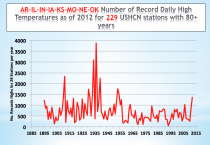
Enlarged
The increased CO2 has helped invigorate crop and make them more DROUGHT RESISTANT.
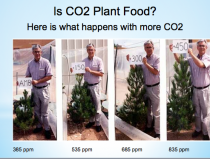
Enlarged
Corn yields were down modestly despite the worst drought since perhaps the middle 1950s. They were much lower in the worst hot lower, but despite the broad coverage of drought, for the US the yields were comparable to the 1900s and well above the levels of 1988 and the 1950s and 1930s. Of course a lot of the improvement in hybrids, better practices, increased irrigation, better fertilizer and disease controls.
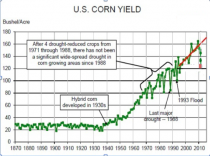
Enlarged
Some farmers acknowledge that this drought is the worst they have ever seen, he says, though he accepts that most argue that it is no different from anything that went before.
“n the heartland of the US that is the prevailing view among many because we have these cycles all the time,""said Rice. “But our analysis over 100 years shows we are seeing longer growing periods, with earlier springs and later falls. With a longer growing season you are going to need more water.”
Farmers aren/t convinced, and in a “Red” state like Kansas, Republican supporters believe Obama’s concerns about climate change are driven by something else.
“Everything he says is for his agenda,” says Kenny Henriksen, without elaborating, before sipping on a coffee in Pinky’s diner.
Feb 18, 2013
Old Time New England Winter
By Harold Ambler
I live in a historic part of a historic New England town: East Greenwich, Rhode Island, to be precise.
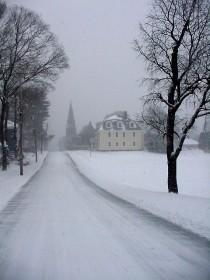
It’s tough to walk five minutes in any direction here without running across a cemetery or two with graves from two or three centuries back. The cemeteries range in size from 20 plots to 2,000.
Our part of town is known as the Hill. You can see it in the picture I chose for the blog today. In fact, the church spire in the background of the photo is the one belonging to our family church, St. Luke’s Episcopal. The open space in the right foreground is Academy Field, where sledding, baseball, soccer, and dog exercising manage to share time and space with admirable ease throughout the year.
In last weekend’s blizzard, the town got covered by pretty much exactly two feet of snow, which had the effect of turning it, for a time, into another town entirely. Street corners, after the endless plowing, were piled so deep in the white stuff that it looked unreal somehow, as though trapdoors had been opened at strategic spots in the clouds. The reality of the event took days to process.
By contrast, the storm that clipped us last night was less than generous in terms of what it left us. Although it is hard to know exactly, so powdery was what fell, and so strong the wind that blew, I will say that we received between 4 and 5 inches.
Intriguingly, though, the taste of winter from the more recent event is stronger than what the blizzard gave. The storm, like last week’s, wound up offshore so intensely that an eye formed, and the wind that has blown all day has covered the once-cleanly plowed streets with snow for a second time.
Walking my dog just now under the black trees and the cold stars and the sliver of frozen moon, the wind sent up puff after puff of snow, some of it local, but some of it, inevitably, from fields, farms, and homes to our west. It’s that kind of night, and that kind of wind, when a thin spray of snow is in the air all the time and gusts spill ground snow onto the streets in feathered gobs.
The temperature is 20 degrees, but when the wind gusts, the assault of cold on skin, flesh, and bones is what crazy kids from California like myself yearn for: Arctic fury, old time winter, here and now.
The neighborhood is quiet, apart from the loud gusts of wind whooshing by. Not a lot of people consider it prime walking weather, and of course I understand. That said, I am noticing a curious thing in modern New England. So little time do people spend outdoors that they barely notice when an old-timey winter takes place right outside their door. They rush to and from their cars, dressed for temperatures 40 degrees warmer than what the elements call for, shiver for a few minutes until the heat takes the chill off in their vehicles, and then rush from the car to wherever they’re going on the other end.
Sure, there are people who sled and ski and skate and run and walk in winter. But, increasingly, they are exceptions to the rule. The mass of humanity here that retreats from the elements has gotten so insulated from nature, and from the glory of a night like to night, for instance, that they can be led by the nose when it comes to weather and climate. Whole world’s burning up? Must be, it says so right here. Plus, didn’t I see a video of a glacier melting, or something? Winter’s a thing of the past? Must be, I don’t even need a jacket anymore. And so on.
Is it a little depressing to hear people talk of global warming, knowing that they’re really talking about the growing wedge between themselves and the natural world, in all too many cases?
Yes, it is. Don’t sell your coat.
Feb 13, 2013
Even liberal media sees through SOTU exaggerations
“"The truth is the truth even if nobody believes it, and error is error even if every everyone believes it.” Bishop Fulton J. Sheen
WASHINGTON - President Barack Obama did some cherry-picking Tuesday night in defense of his record on jobs and laid out a conditional path to citizenship for illegal immigrants that may be less onerous than he made it sound.
A look at some of the claims in his State of the Union speech, a glance at the Republican counterargument and how they fit with the facts:
OBAMA: “After years of grueling recession, our businesses have created over 6 million new jobs.”
THE FACTS: That’s in the ballpark, as far as it goes. But Obama starts his count not when he took office, but from the point in his first term when job losses were the highest. In doing so, he ignores the 5 million or so jobs that were lost on his watch, up to that point.
Private sector jobs have grown by 6.1 million since February 2010. But since he became president, the gain is a more modest 1.9 million.
And when losses in public sector employment are added to the mix, his overall jobs record is a gain of 1.2 million.
___
OBAMA: “We have doubled the distance our cars will go on a gallon of gas.”
THE FACTS: Not so fast.
That’s expected to happen in 12 more years.
Under a deal the Obama administration reached with automakers in 2011, vehicles will have a corporate average fuel economy of 54.5 miles per gallon by 2025, twice the 27 miles per gallon, on average, that cars and trucks get today. Automobile manufacturers won’t start making changes to achieve the new fuel economy standards until model year 2017. Not all cars will double their gas mileage, since the standard is based on an average of a manufacturers’ fleet.
___
OBAMA: “Already the Affordable Care Act is helping to reduce the growth of health care costs.”
THE FACTS: The jury is still out on whether Obama’s health care overhaul will reduce the growth of health care costs. It’s true that cost INCREASES have eased, but many experts say that’s due to the sluggish economy, not to the health care law, whose main provisions are not yet fully in effect.
___
OBAMA: “Real reform means establishing a responsible pathway to earned citizenship – a path that includes passing a background check, paying taxes and a meaningful penalty, learning English and going to the back of the line behind the folks trying to come here legally.”
THE FACTS: The seemingly stern admonition that illegal immigrants must go to the back of the line, often heard from the president, doesn’t appear to have much practical effect except in the most obvious sense. Everyone who joins a line, whether for a movie, a coffee or citizenship, starts at the back of that particular line. It’s not clear he is saying anything more than that illegal immigrants won’t get to cut in line for citizenship once they’ve obtained provisional legal status.
Like those living abroad who have applied to come to the U.S. legally, illegal immigrants who qualify for Obama’s proposed path to citizenship will surely face long waits to be processed. But during that time, they are already in the U.S. and will get to stay, work and travel in the country under their new status as provisional immigrants, while those outside the U.S. simply have to wait.
Sending illegal immigrants to the “back of the line” is something of a distinction without a difference for some legal immigrants who dutifully followed all the rules before coming to the United States.
For instance, some legal immigrants who are in the U.S. on an employer-sponsored visa can’t easily change jobs, or in some cases take a promotion, without jeopardizing their place in line to get a green card. In other cases, would-be legal immigrants in other countries wait for years to be able to settle in the U.S.
Obama is using “back of the line” somewhat figuratively, because there are multiple lines depending on the applicant’s relationship with family already in the U.S. or with an employer. Generally, a foreign-born spouse of a U.S. citizen or someone with needed skills and a job offer will be accepted more quickly than many others.
But even as a figurative point, his assertion may cloak the fact that people who came to the U.S. illegally and win provisional status have the great advantage over applicants abroad of already being where they all want to go.
___
OBAMA: “"Study after study shows that the sooner a child begins learning, the better he or she does down the road. ... And for poor kids who need help the most, this lack of access to preschool education can shadow them for the rest of their lives. ... Every dollar we invest in high-quality early education can save more than $7 later on - by boosting graduation rates, reducing teen pregnancy, even reducing violent crime.”
THE FACTS: Dozens of studies have shown Head Start graduates are more likely to complete high school than their at-risk peers who don’t participate in the program. But a study last year by the Department of Health and Human Services that found big vocabulary and social development gains for at-risk students in pre-kindergarten programs also found those effects largely faded by the time pupils reached third grade. The report didn’t explain why the kids saw a drop-off in performance or predict how they would fare as they aged. Try our failing, inferior public education system
_____
OBAMA: “I urge this Congress to pursue a bipartisan, market-based solution to climate change, like the one John McCain and Joe Lieberman worked on together a few years ago. But if Congress won’t act soon to protect future generations, I will. I will direct my Cabinet to come up with executive actions we can take, now and in the future, to reduce pollution, prepare our communities for the consequences of climate change and speed the transition to more sustainable sources of energy.”
THE FACTS: Obama failed to get a global warming bill through Congress when both Houses were controlled by Democrats in 2010. With Republicans in control of the House, the chances of a bill to limit the gases blamed for global warming and to create a market for businesses to trade pollution credits are close to zero. The Obama administration has already acted to control greenhouse gases through existing law. It has boosted fuel-efficiency standards and proposed rules to control heat-trapping emissions from new power plants. And while there are still other ways to address climate change without Congress, it’s questionable regulation alone can achieve the reductions needed to start curbing global warming.
Icecap Note: The claim that 12 of the hottest years ever for the planet have occurred in the last 15 years is a flat out lie (source Karl/Peterson not the POTUS). Adjustments made to cool the past and warm the current have elevated the temperatures above past hot years artificially. A few years like 2005 and 1998 may rank but that is to be expected with the warm AMO.
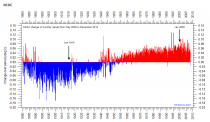
Enlarged. Changes made since 2008, when UHI was removed from USHCN and other adjustments to algorithms made on top to a series of other similar prior warmings. The 0.25C+ added warming is enough to guarantee that almost any year now will rank.
See this draft paper that was later peer reviewed, edited and appeared in Elsevier’s Evidence Based Climate Change. Anthony Watts has authored a paper that shows 1/2 of the warming since 1979 is due to bad siting and UHI which IS NOT ADJUSTED FOR in the global and now the US data even though the majority of remaining stations are airports and cities/towns. Airports are more urban now than rural. The paper and other posts have shown how this has made the last two decades appear warmer than other decades when we are just comparable to the last 20 year peak in the 60-70 year ocean driven cycles. The nonsense is used to support more stimulus dollars for supporters (crony capitalism) and another shot at the failed green agenda that Europe is running fast away from. The claim of green jobs was proven false in Spain and Italy and the UK where 2.2 to 3.4 real jobs were lost for every green job created and only 1 in 10 green job proved to be permanent. Spain’s unemployment soared to 25.5% and energy costs increased as much as 75% in Europe with more to come. BTW not a single fossil fuel plant was shut down because wind and solar were so unreliable and because these fossil fuel plants operate in inefficient back up modes, the amount of CO2 emissions went UP 33 to 50%, not down. Over 25% of the people in Wales are in energy poverty - many pensioners who must decide between heating and eating. I am meeting with congress later this month to fight the lobbying efforts of the AMS and other societies to enact carbon taxes and other green policies. I have fought back against the EPA by supporting a Science Amicus brief prior to WB that went to the DC Circuit court. Please help ICECAP fight back this tyranny and racketeering by environmentalists and academia and the (un)professional societies by donating even a small amount to help defray the costs of these efforts by our small staff and pay the bills for the site for maintenance and security that come out of my pocket every month.
|









